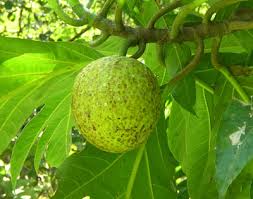Breadfruit
Artocarpus altilis
MORACEAE 

The Moraceae are mainly trees of warm regions, rarely herbs or shrubs; There are 60 genera and over 1000 species.
Almost all of these plants secrete a colorless or white latex, sometimes toxic.
Many trees are wanted or grown for their secretion (Panama rubber tree milk of Venezuela) for their bark, by beating, gives plant tissues (tapa), both in the Ashanti of Ghana (Antiaris africana) that among the ancient Polynesians (Broussonetia papyrifera and Artocarpus altilis).
In the genus Ficus found the fig European, Asian banyan the venerable and majestic as the "rubber" apartment (Ficus elastica).
Breadfruit is a garden variety of wildlife species native to Southeast Asia or Micronesia, known fifty species of Artocarpus. Selected by humans, breadfruit have generally lost their power of reproduction by seed (which may be hybrids) and they can not be propagated by layering or using root discharges.
The breadfruit tree can reach a large size, its leaves are well developed, more or less cut by variety; fruit globules 1 to 5 kg are ripe, green-yellow, covered with small drops of white latex.
The Polynesians recognized dozens of crop varieties with a single-seeded (the "chestnut"). These trees are now widespread throughout the tropical world, but Europeans do not know the existence before the "discovery" of Tahiti.
At the end of the 18th century the British decided to introduce it in their crops from Caribbean to feed the abundant labor, the rest is history, Bligh and the Bounty, the long stay in Tahiti select and ship more than 1,000 young trees, and the mutiny which broke out shortly after the start of Polynesia, partly because of abuse of power by the captain but also because of the restriction of drinking water, these trees need much water to survive.
Two years later, Bligh successfully introduced the breadfruit to the Caribbean (St. Vincent), the French the acclimatized a little later in Guyana.
COMPOSITION AND CHEMICAL PROPERTIES
The fruit of the tree fresh bread contains on average:
70% water,
5% carbohydrate,
1.5% protein,
0.5% fat,
1.5% cellulose, mineral substances,
some vitamin C and vitamin A but B1 and B2.
The latex (emulsion is) quickly separates into 2 parts, one aqueous, the other rubbery, and contains an enzyme, papayotine.
In leaves and petioles there is little tannin.
All this is commonplace and does not justify the establishment of this tree in a directory of medicinal plants, there is yet another reason.
Thanks to the breadfruit that Maohi have colonized the Marquesas Islands (called there "Tumu mei"), have developed a civilization and a very unique island culture, have survived simply on these Islands austere climate very irregular, alternating wet years and droughts.
For hundreds of years, they are fed almost exclusively the fruit of the breadfruit (mei), animal proteins are scarce or taboo (forbidden) for most men and almost all women, and other food crops scarce (rare taro and bananas except during drought).
However, the first navigators who reached these islands were amazed at the physical power of the warriors "Marquesas", their imposing stature, gigantic books they managed to raise, and in general good health.
The effectiveness of dietary "mei" is probably due to how the Polynesians prepared. When the harvest was plentiful, they proceeded to a ripe fruit silage, lactic fermentation, which occurs while guaranteeing the preservation of pulp "mei" and significantly altered its nutritional value.
The fermented dough is kept for months and even years, we incorporated after cooking, by beating and mixing with the pestle of stone, the "mei" freshly cooked, and got the "popoi" nourishing and dietetic very effective.
USES
We may regret the virtual abandonment of this culinary technique, many Polynesians are now diabetic carbohydrate overfeeding, and wonder if a modern assessment of this traditional food is not desirable.
Other uses: The latex is used, both in South America in the Pacific, to make poultices to sprains, muscle strains, bruises. It is applied directly or after impregnation of a band of tissue which surround the painful joint. The presence of papayotine probably helps the absorption of inflammatory edema. The Guyanese Creole consume a concoction of leaves to lower blood pressure, many artocarpus indeed contain cardenolides.
But when the "popoi" Marquesas Islands on the shelves of supermarkets Western diet? !
0 commentaires